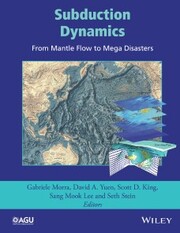-
Zusatztext
-
<p>Subduction dynamics has been actively studied through seismology, mineral physics, and laboratory and numerical experiments. Understanding the dynamics of the subducting slab is critical to a better understanding of the primary societally relevant natural hazards emerging from our planetary interior, the megathrust earthquakes and consequent tsunamis.</p><p><i>Subduction Dynamics</i> is the result of a meeting that was held between August 19 and 22, 2012 on Jeju island, South Korea, where about fifty researchers from East Asia, North America and Europe met. Chapters treat diverse topics ranging from the response of the ionosphere to earthquake and tsunamis, to the origin of mid-continental volcanism thousands kilometers distant from the subduction zone, from the mysterious deep earthquakes triggered in the interior of the descending slabs, to the detailed pattern of accretionary wedges in convergent zones, from the induced mantle flow in the deep mantle, to the nature of the paradigms of earthquake occurrence, showing that all of them ultimately are due to the subduction process.</p><p>Volume highlights include:</p><ul><li>Multidisciplinary research involving geology, mineral physics, geophysics and geodynamics</li><li>Extremely large-scale numerical models with sliate-of-the art high performance computing facilities</li><li>Overview of exceptional three-dimensional dynamic representation of the evolution of the Earth interiors and of the earthquake and subsequent tsunami dynamics</li><li>Global risk assessment strategies in predicting natural disasters</li></ul><p>This volume is a valuable contribution in earth and environmental sciences that will assist with understanding the mechanisms behind plate tectonics and predicting and mitigating future natural hazards like earthquakes, volcanoes and tsunamis.</p>
-
-
Kurztext
-
Subduction dynamics has been actively studied through seismology, mineral physics, and laboratory and numerical experiments. Understanding the dynamics of the subducting slab is critical to a better understanding of the primary societally relevant natural hazards emerging from our planetary interior, the megathrust earthquakes and consequent tsunamis. Subduction Dynamics is the result of a meeting that was held between August 19 and 22, 2012 on Jeju island, South Korea, where about fifty researchers from East Asia, North America and Europe met. Chapters treat diverse topics ranging from the response of the ionosphere to earthquake and tsunamis, to the origin of mid-continental volcanism thousands kilometers distant from the subduction zone, from the mysterious deep earthquakes triggered in the interior of the descending slabs, to the detailed pattern of accretionary wedges in convergent zones, from the induced mantle flow in the deep mantle, to the nature of the paradigms of earthquake occurrence, showing that all of them ultimately are due to the subduction process. Volume highlights include: Multidisciplinary research involving geology, mineral physics, geophysics and geodynamics Extremely large-scale numerical models with sliate-of-the art high performance computing facilities Overview of exceptional three-dimensional dynamic representation of the evolution of the Earth interiors and of the earthquake and subsequent tsunami dynamics Global risk assessment strategies in predicting natural disasters This volume is a valuable contribution in earth and environmental sciences that will assist with understanding the mechanisms behind plate tectonics and predicting and mitigating future natural hazards like earthquakes, volcanoes and tsunamis.
-
-
Autorenportrait
- <p><b>Gabriele Morra</b> is an Assistant Professor in the department of Physics at the University of Louisiana in Lafayette. He has co-authored several research articles including Geochemistry, Geophysics, Geosystems. His research interests revolve around geodynamics, tectonics and numerical modeling methods.</p><p><b>David A. Yuen</b> is a Professor in the Department of Earth Sciences in University of Minnesota. He has been the lead author in several high impact journal articles including Geochemistry, Geophysics, Geosystems. He has also authored an article in the Proceedings of the National Academy of Sciences. His research focuses on numerical modeling of geophysical and geological phenomena.</p><p><b>Scott King</b> is the Professor in the department of Geophysics in Virginia Tech. He has published in leading geology journals including Geochemistry, Geophysics, Geosystems, Geophysical Journal International, Geology and Nature Geoscience. His research focuses on the dynamics and evolution of the interior of the terrestrial planets.</p><p><b>Sang Mook Lee</b> is an Associate Professor in the School of Earth and Environmental Sciences and Chair of Marine Geophysics at Seoul National University in Korea. He is the Principle Investigator and Director at the Center for Quality of Life Technology, Ministry of Knowledge. His research focuses on oceanography, marine geology and geophysics, geodynamics and plate tectonics. He is a young scientist with an unfortunate field trip accident that paralyzed him at the age of 40 and so very few representative publications are known.</p><p><b>Seth Stein</b> is the William Deering Professor in the Department of Earth and Planetary Sciences in Northwestern University at Illinois. He has published 6 books in Geophysical Monograph Series and Geodynamics Series. He has over 100 research articles including the Geophysical Research Letters. His research focuses on plate tectonics, seismology, and space geodesy with special emphasis on investigating plate boundary processes and deformation within the lithosphere using a range of techniques including space-based geodesy, seismology, and marine geophysics.</p>
Detailansicht
Subduction Dynamics
eBook - From Mantle Flow to Mega Disasters, Geophysical Monograph Series
ISBN/EAN: 9781118888940
Umbreit-Nr.: 8655650
Sprache:
Englisch
Umfang: 210 S., 33.07 MB
Format in cm:
Einband:
Keine Angabe
Erschienen am 18.09.2015
Auflage: 1/2015
E-Book
Format: PDF
DRM: Adobe DRM


